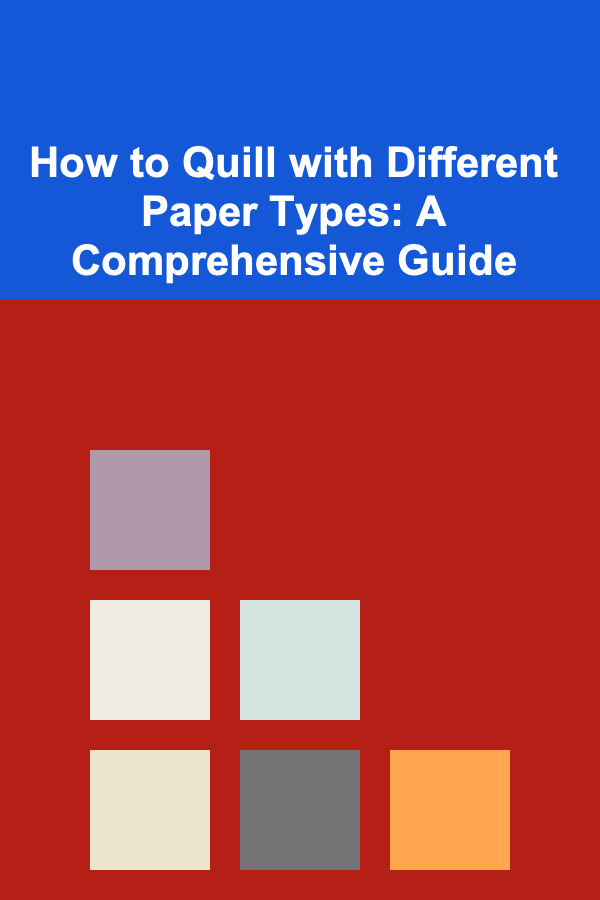
How to Quill with Different Paper Types: A Comprehensive Guide
ebook include PDF & Audio bundle (Micro Guide)
$12.99$9.99
Limited Time Offer! Order within the next:

Quilling, or paper filigree, is the art of rolling, shaping, and gluing strips of paper to create decorative designs. This fascinating craft has been practiced for centuries, but it has gained renewed popularity in recent years due to its versatility and the stunning results it can produce. Whether you're crafting intricate greeting cards, creating wall art, or making small decorative items, quilling offers endless possibilities.
However, one of the key factors that influence the success of a quilling project is the type of paper used. Different papers yield different results, and choosing the right one for your project is essential for achieving the desired effects. In this comprehensive guide, we'll explore how to quill with different paper types, discussing the benefits, challenges, and techniques associated with each paper variety.
Understanding Paper Types for Quilling
Before diving into the specifics, it's important to understand the various types of paper you can use for quilling. Each paper type has its unique texture, weight, and qualities, which can affect how easily the paper is shaped, how crisp the edges are, and how well it holds its form over time.
Some of the most commonly used paper types for quilling include:
- Quilling Paper Strips
- Cardstock
- Tissue Paper
- Crepe Paper
- Watercolor Paper
- Handmade Paper
- Vellum Paper
Let's break down each paper type and explore its characteristics and best uses.
Quilling Paper Strips
Quilling paper strips are the most commonly used paper in quilling projects. These strips are specially cut to a uniform width, typically ranging from 1/8 inch to 1/4 inch, and are available in a wide array of colors and finishes. They are designed specifically for quilling, which means they are the easiest to work with and provide the best results for most quilling projects.
Benefits of Quilling Paper Strips
- Perfect for Quilling: They are pre-cut to the ideal width and are often the perfect thickness for creating crisp and well-defined coils and shapes.
- Variety of Colors and Finishes: Quilling paper strips come in a wide variety of colors, patterns, and finishes such as matte, glossy, metallic, and glittered.
- Ease of Use: The strips are easy to roll and shape, and they tend to hold their form well once glued.
Challenges
- Limited Texture: While quilling paper strips are great for most designs, they do not offer much in terms of texture or variation compared to some of the other paper types.
Best Uses
- Greeting Cards: Quilling paper is the go-to choice for creating intricate and detailed designs for cards.
- Framed Artwork: For larger, more detailed quilling projects like wall art, quilling paper strips provide the precision and stability needed to create sharp, clean lines and shapes.
Techniques
- Basic Coiling: Start by rolling the strip around a quilling tool, adjusting the tightness to control the size of the coil. Once you have the desired shape, glue the end to secure the coil.
- Pinching: To create teardrop or leaf shapes, pinch the edges of the coil between your fingers and glue them into place.
Cardstock
Cardstock is a thicker, heavier paper that is often used for scrapbooking and card making. It's stiffer than quilling paper and comes in a variety of finishes and weights. When used for quilling, cardstock can create a more rigid, sturdy design.
Benefits of Cardstock
- Durability: Cardstock is strong and can hold its shape very well, making it ideal for projects that need to be robust, such as 3D designs or embellishments.
- Variety of Finishes: Cardstock comes in many different textures and finishes, from smooth to textured, and in a range of colors.
Challenges
- Difficulty Rolling: Due to its stiffness, cardstock can be harder to roll and manipulate than quilling paper strips. It can also be challenging to get clean, tight coils.
- Requires More Effort: Since it's thicker, cardstock may require more pressure to get the desired shapes and might not hold small, delicate shapes as easily as quilling paper.
Best Uses
- 3D Quilling Projects: If you're making 3D flowers, sculptures, or other robust designs, cardstock is a great choice for adding structure.
- Quilled Embellishments: Cardstock can be used for making quilled embellishments on scrapbooking pages or greeting cards, where durability is important.
Techniques
- Cut into Strips: When using cardstock, consider cutting it into thinner strips than typical quilling paper, as this will make it easier to manipulate.
- Softening the Paper: Use a bone folder or your fingers to gently soften the cardstock before rolling to make the paper more flexible.
Tissue Paper
Tissue paper is a lightweight, delicate material that adds a soft, ethereal quality to quilling projects. It's often used for adding layers of texture or creating lightweight designs.
Benefits of Tissue Paper
- Soft Texture: Tissue paper's light texture makes it ideal for creating delicate, airy quilled pieces.
- Unique Effects: Tissue paper can be dyed or painted, providing a unique appearance for your quilling projects.
- Inexpensive: Tissue paper is often cheaper than other types of quilling paper, making it a great option for experimenting.
Challenges
- Fragility: Tissue paper is fragile and can tear easily, especially when rolling or shaping. It can also be challenging to keep the edges crisp.
- Less Definition: Because of its softness, tissue paper may not hold the crisp shapes of coils as well as thicker paper types.
Best Uses
- Light and Airy Designs: Tissue paper is perfect for creating light, whimsical designs or adding a delicate touch to a larger project.
- Layered Designs: Use tissue paper to create multi-dimensional effects, where layers of quilling are built up to add depth.
Techniques
- Layering: Layer different colors of tissue paper for a more complex effect, such as creating a 3D flower or butterfly.
- Stiffening: If you need to stiffen tissue paper, consider lightly gluing it to a piece of cardstock before using it for quilling.
Crepe Paper
Crepe paper is a textured paper with a slight stretch. It has a crinkled surface that adds depth and texture to quilled pieces. It's often used for flower making and other designs that require a little more movement or flexibility.
Benefits of Crepe Paper
- Textured Look: The crinkled texture of crepe paper adds a unique, dimensional quality to your designs.
- Flexibility: Crepe paper can stretch slightly, allowing for more intricate shapes and movements.
- Vibrancy: Crepe paper is available in a wide variety of vibrant, rich colors.
Challenges
- Not Ideal for Tight Coils: Crepe paper tends to stretch and lose its shape when rolled too tightly, making it difficult to create defined coils.
- May Require Additional Tools: To get the best results with crepe paper, you may need to use special tools or adhesives to secure the shapes.
Best Uses
- Flowers: Crepe paper is often used to create paper flowers with a more organic, textured look.
- Loose, Flowing Designs: For projects that require flexibility and texture, crepe paper is an excellent choice.
Techniques
- Stretching: To use crepe paper effectively, you may want to stretch it slightly before rolling it into coils. This will help it hold its shape and add a natural flow to your design.
- Fringed Edges: Crepe paper can be cut into fringed strips, perfect for creating petals or other intricate details.
Watercolor Paper
Watercolor paper is thick, textured paper designed to hold up to watercolor paints. It's often used in quilling for its robust nature and ability to support mixed-media projects.
Benefits of Watercolor Paper
- Texture: Watercolor paper's texture provides a more artistic, hand-crafted feel to your quilling projects.
- Durability: It's strong and holds shapes well, making it perfect for 3D designs or intricate quilling.
Challenges
- Thicker Paper: Like cardstock, watercolor paper can be difficult to roll and manipulate, especially when creating smaller designs.
- Cost: Watercolor paper tends to be more expensive than basic quilling strips.
Best Uses
- Mixed Media Projects: If you're planning to combine quilling with watercolor painting, watercolor paper is an excellent choice.
- Textured Designs: For designs that need a textured, rustic feel, watercolor paper provides the perfect backdrop.
Techniques
- Pre-Cutting: Watercolor paper can be tough to cut into strips, so make sure you use a paper cutter or sharp scissors for precision.
- Rolling: Because watercolor paper is thick, use a quilling tool with a larger tip to ensure smooth rolling.
Handmade Paper
Handmade paper is a type of paper that is crafted by hand, often containing fibers, flowers, or other elements embedded in the paper. It's highly textured and unique in appearance, adding a rustic or vintage touch to your quilling projects.
Benefits of Handmade Paper
- Unique Textures: Each sheet of handmade paper is one-of-a-kind, adding a distinctive look to your quilled designs.
- Eco-friendly: Many types of handmade paper are made from recycled materials, making them an environmentally friendly option.
Challenges
- Unpredictable Texture: The texture can vary significantly from sheet to sheet, which might make it challenging to work with for precise quilling.
- Fragility: Some handmade papers are delicate and can tear easily during the quilling process.
Best Uses
- Vintage or Rustic Designs: Handmade paper is ideal for creating designs with an earthy, natural feel.
- Special Occasion Cards: Use handmade paper for unique, one-of-a-kind greeting cards or invitations.
Techniques
- Test Before Using: Since handmade paper can vary in thickness, it's a good idea to test a small piece before committing to a full project.
- Gentle Rolling: Be gentle when rolling handmade paper to avoid tearing. Consider using a quilling tool with a softer touch.
Vellum Paper
Vellum paper is semi-transparent and has a smooth texture. It's often used in calligraphy and scrapbooking, but it can also be used for quilling, particularly when a delicate, ethereal look is desired.
Benefits of Vellum Paper
- Translucency: Vellum's translucent quality adds a soft, glowing effect to your quilling.
- Smooth Texture: The smooth surface of vellum makes it easy to work with, as it glides through quilling tools effortlessly.
Challenges
- Weak Structure: Vellum paper is thinner and less sturdy than cardstock or quilling paper, which can make it harder to maintain complex shapes.
- Requires Careful Handling: Since it's delicate, it requires more attention during handling to avoid tearing.
Best Uses
- Delicate, Soft Designs: Vellum is ideal for making light, airy pieces like butterflies, flowers, or other whimsical designs.
- Layered Projects: Vellum works well in layered projects where its transparency can be a beautiful feature.
Techniques
- Gentle Rolling: Roll vellum lightly to avoid crushing or tearing. It may also be helpful to use a quilling tool with a smooth surface to prevent snagging.
Conclusion
The choice of paper for your quilling projects greatly influences the outcome of your designs. From the precise, uniform rolls of quilling paper strips to the textured, organic look of handmade paper, each type of paper offers unique qualities that can enhance your quilling experience. By understanding the characteristics of each paper type and adjusting your techniques accordingly, you can create stunning, intricate, and personalized quilled pieces that showcase your creativity and skill.
Reading More From Our Other Websites
- [Home Renovating 101] How to Create a Sustainable Garden During Your Home Renovation
- [Home Staging 101] Best Home Staging Methods to Make Your Property Stand Out in the Market
- [Home Maintenance 101] How to Prepare Your Appliances for Seasonal Changes
- [Home Budget Decorating 101] How to Incorporate Trendy Decor Elements Without Breaking the Bank
- [Home Renovating 101] How to Install New Light Fixtures for a Modern Look
- [Hiking with Kids Tip 101] Trail-Ready Kids: Essential Hiking Safety Rules Every Young Adventurer Needs
- [Personal Finance Management 101] How to Master the Art of Negotiating for Better Pay and Benefits
- [Reading Habit Tip 101] From Bookworm to Book Champion: A Step-by-Step Guide to Cultivating a Lifelong Reading Habit
- [Personal Care Tips 101] How to Select an Acne Treatment Cream for Adult Acne
- [Organization Tip 101] How to Organize Your Music and Movie Collections

How to Create AI Products and Sell Them for Passive Income
Read More
How to Identify High-Quality Dividend Stocks for Passive Income
Read More
How to Update Your Home's Lighting for a Modern Look
Read More
Unlocking Success as a Tax Consultant: A Comprehensive Guide to Tax Advisory Services
Read More
Why Organizing Your Bathroom Products Can Reduce Stress
Read More
10 Tips for Optimizing Warehouse Layout as a Logistics Coordinator
Read MoreOther Products

How to Create AI Products and Sell Them for Passive Income
Read More
How to Identify High-Quality Dividend Stocks for Passive Income
Read More
How to Update Your Home's Lighting for a Modern Look
Read More
Unlocking Success as a Tax Consultant: A Comprehensive Guide to Tax Advisory Services
Read More
Why Organizing Your Bathroom Products Can Reduce Stress
Read More